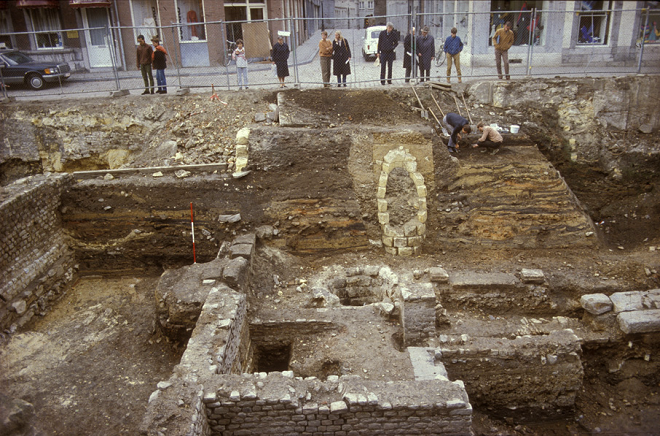
 |
| Fig. 41: In 1983, numerous remains of the city's Roman and medieval past were found during the excavation under the Hotel Derlon |
Four to six meters below the current Plankstraat are the remains of the first Roman road in Maastricht, a so-called Heerbaan, which led the armies of the Roman occupiers from the Maas in a westerly direction. This road was part of an extensive network of roads that opened up the northerly Roman Empire. This earliest version of Maastricht was a strip-like settlement along that road, which runs under the current city center and continues on the north side of the Vrijthof, thereby exiting the Maas valley. However, when they arrived, the Romans had not entered an empty territory. When Caesar arrived in these parts as a general in 58 BCE, he encountered considerable resistance from the then-inhabitants, the Eburones. The Eburones had a height-reinforcement just south of Maastricht and gave Caesar his greatest loss ever when one and a half legions were destroyed in 54 BCE. The Eburones undoubtedly used a shallow passage through the Meuse "near Maastricht" to cross the river.
 |
| Fig. 42: Reconstruction of Roman Maastricht in the first centuries of the era: a strip-like settlement with a sanctuary, thermal baths and inns |
The Romans built the first bridge in the same place shortly after the era, which has been rebuilt several times. Around the year 100 CE, a real trading settlement had been established with inns, a sanctuary, houses of traders and craftsmen. Remains of a Roman thermal complex have also been found, as has a completely intact cellar that was built under a house. The area outside the city was built up with rural villas, which grew food for the city and the army. The Roman peace period (the pax romana) from 27 BCE to 180 CE was a relatively peaceful and prosperous period in history. It was not until the fourth century that a small stone camp, a castellum, was built in Maastricht over the Roman road to control both the road and the bridge as Germanic troops had revolted and invaded the Roman Empire. That castellum existed for several centuries, but whether it was ever actually besieged and how many soldiers were stationed there is unknown. Around the year 800 CE, the last traces of the castellum disappeared and the Roman history slowly faded into oblivion.
Reference:
Panhuysen, T.A.S.M., Romeins Maastricht en zijn beelden, Maastricht/Assen, 1996.